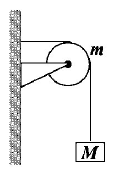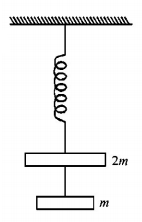Question
Two particles of equal mass are connected to a rope $$AB$$ of negligible mass such that one is at end $$A$$ and other dividing the length of rope in the ratio $$1 : 2$$ from $$B.$$ The rope is rotated about end $$B$$ in a horizontal plane. Ratio of tensions in the smaller part to the other is (ignore effect of gravity)
A.
$$4:3$$
B.
$$1:4$$
C.
$$1:2$$
D.
$$1:3$$
Answer :
$$4:3$$
Solution :

$$\eqalign{ & {T_1} = m{\omega ^2}\left( {3\ell } \right) \cr & {\text{and}}\,{T_2} - {T_1} = m{\omega ^2}\ell \cr & {\text{or}}\,\,{T_2} = {T_1} + m{\omega ^2}\ell = m{\omega ^2}\left( {3\ell } \right) + m{\omega ^2}\ell \cr & = 4m{\omega ^2}\ell \cr & \therefore \frac{{{T_2}}}{{{T_1}}} = \frac{4}{3}. \cr} $$

$$\eqalign{ & {T_1} = m{\omega ^2}\left( {3\ell } \right) \cr & {\text{and}}\,{T_2} - {T_1} = m{\omega ^2}\ell \cr & {\text{or}}\,\,{T_2} = {T_1} + m{\omega ^2}\ell = m{\omega ^2}\left( {3\ell } \right) + m{\omega ^2}\ell \cr & = 4m{\omega ^2}\ell \cr & \therefore \frac{{{T_2}}}{{{T_1}}} = \frac{4}{3}. \cr} $$


